Key takeaways:
- Directing involves understanding emotional beats and adapting to different mediums, with unique challenges in film and theater.
- Collaboration is key; building rapport with cast and crew enhances the creative process and storytelling.
- Flexibility and embracing spontaneity can lead to authentic moments that elevate the final product.
- Clear communication of vision ensures a shared understanding and improves collaboration among team members.
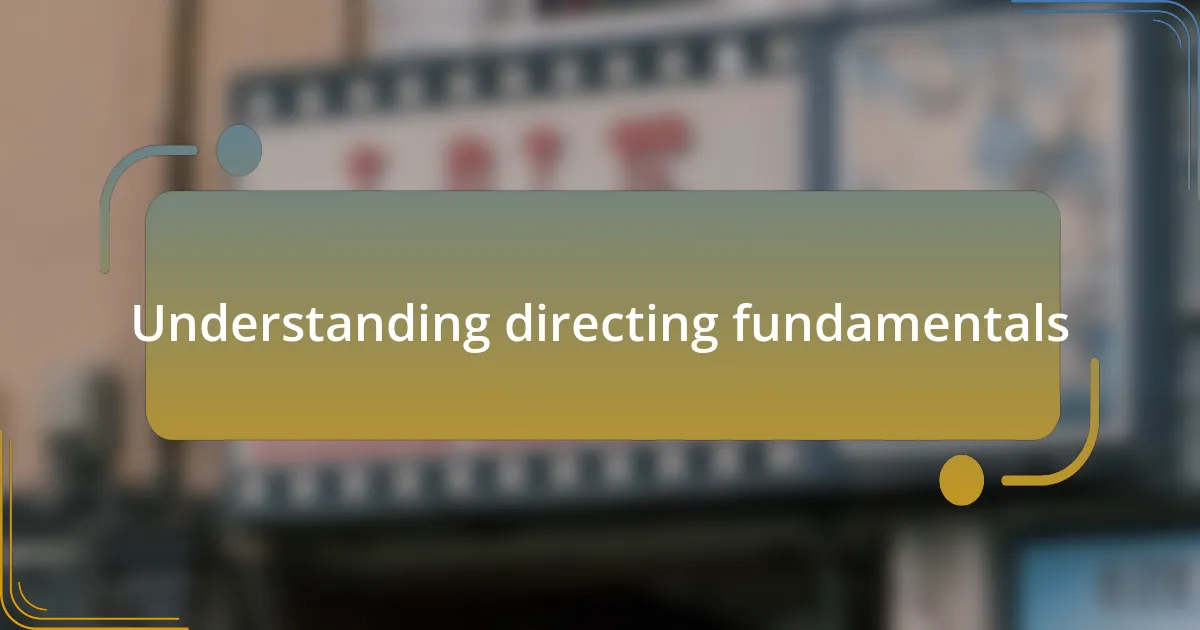
Understanding directing fundamentals
Directing is both an art and a craft that goes beyond merely telling actors what to do. I remember my first experience directing a short film; I quickly learned that understanding emotional beats is crucial. How do you convey a character’s inner turmoil without saying a word? It’s about the subtlety in performances, the way an actor’s demeanor shifts when the stakes are high.
When I transitioned into directing for theater, the immediacy of live performance presented unique challenges. Each night, the audience’s energy was different, and it forced me to adapt in real time. I realized that while a film might allow for multiple takes, theater demands a firm grasp of pacing and timing; there’s no “cut” to rely on, which makes your directorial choices all the more significant.
Moreover, the fundamentals of directing also involve collaboration. In my experience, building a rapport with your cast and crew can make all the difference. Have you ever felt that rush when everyone on set or in the rehearsal room is in sync? There’s an unmatched satisfaction in knowing that your vision is shared, and that tangible connection elevates the final product. Each directing project teaches you something new, and those lessons are what truly shape your unique style.
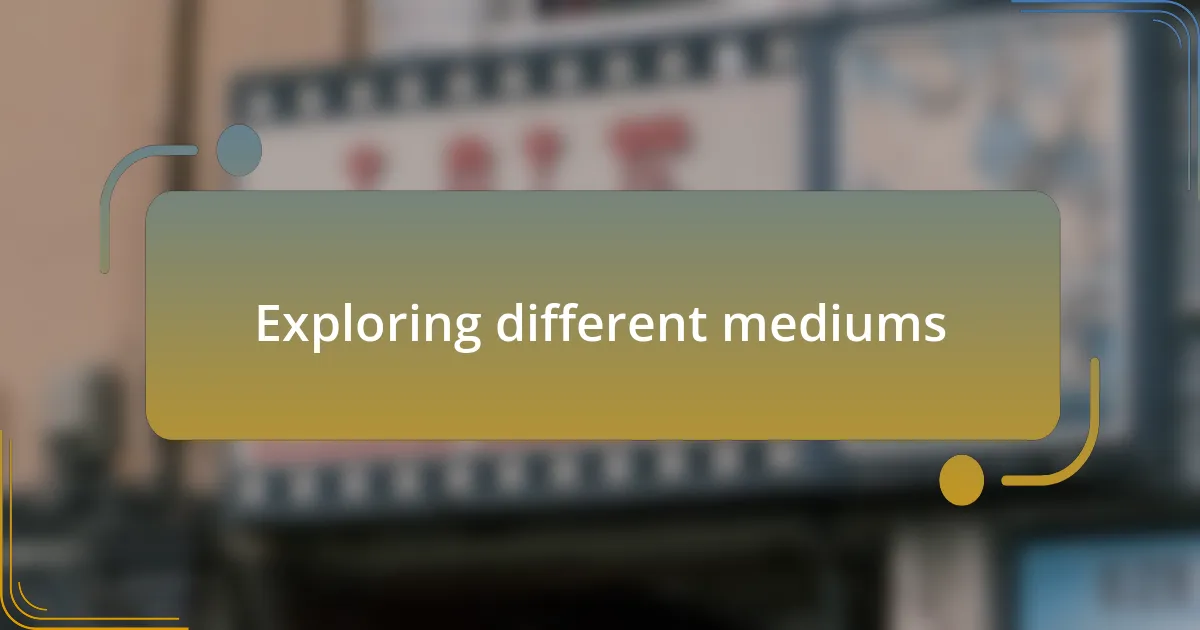
Exploring different mediums
Exploring different mediums has been a journey that has profoundly influenced my directing style. When I first dabbled in web series, I was taken aback by the tight constraints that format imposed. The episodes were short—just a few minutes each—and I found myself focusing on how to make every second count. How do you build character and narrative depth in such a limited timeframe? This challenge forced me to hone my ability to convey emotion swiftly and efficiently, a skill that has since proven invaluable in every project.
Switching from film to documentary directing was a significant shift for me. Unlike scripted narratives, documentaries have a rhythm dictated by real life, and I remember feeling a mix of excitement and anxiety on set. Capturing genuine moments instead of staged performances opened my eyes to the power of authenticity. In this medium, every decision—whether it’s camera placement or background sounds—can dramatically shift the viewer’s perception. I often ask myself, how can I ensure the raw truth of the story shines through? This question continues to guide my approach and highlights the importance of trust between filmmaker and subject.
The versatility required in directing across different mediums has also shaped my collaboration with creative teams. In one instance, while working on an interactive theater production, I discovered that audience participation brought a layer of unpredictability I had never encountered. Each performance felt unique, and I needed to adapt my direction on the fly, a stark contrast to the more controlled environment of film. Was it nerve-wracking? Absolutely! But that thrill of creating a dynamic experience with the audience remains one of the most rewarding aspects of my directing career.
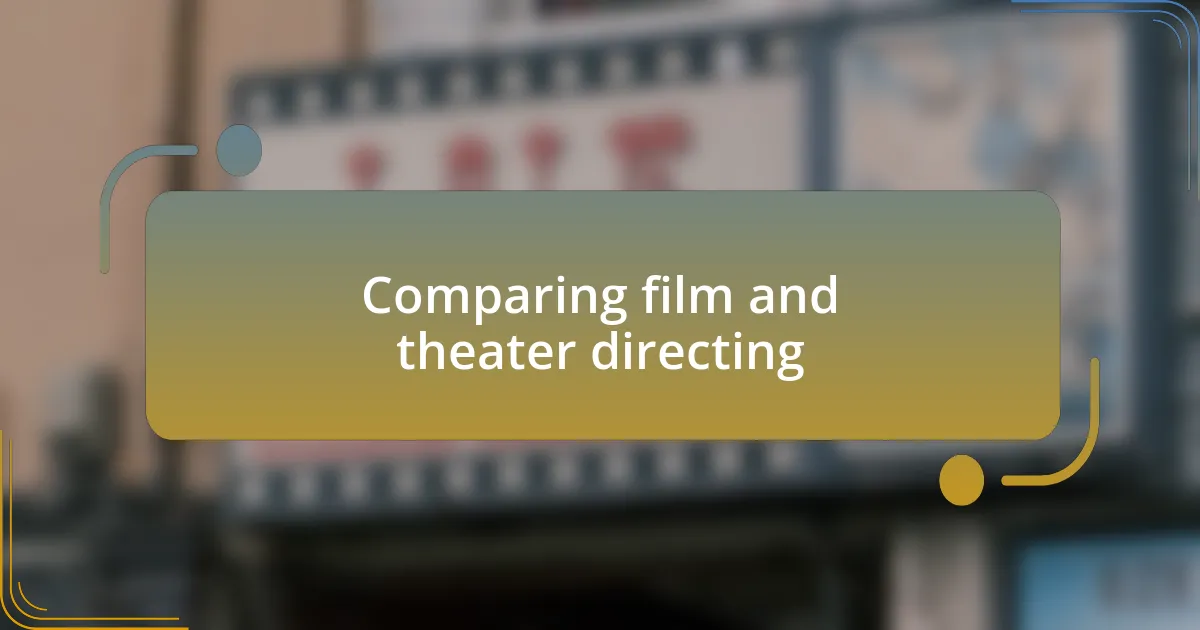
Comparing film and theater directing
Directing theater and film can feel like navigating two different worlds, each with its own rules and rhythms. I clearly remember my first experience directing a theater production—the palpable energy of live performances was both exhilarating and intimidating. The audience’s immediate reactions influenced the actors in real-time, creating an electric atmosphere that’s hard to replicate in film. How do you capture that raw, live excitement in a medium where everything can be meticulously edited?
In contrast, when I directed my first short film, the environment shifted significantly. Filming offered the luxury of multiple takes. I vividly recall the relief of being able to refine a scene until it reached its full potential, unlike theater, where you have just one shot on the night of the performance. Yet, this flexibility also presented a different challenge: conveying emotion consistently across takes without losing that initial spark. I often ask myself, how can I keep the authenticity alive while ensuring the perfect shot?
Moreover, the collaborative dynamics vary greatly between the two mediums. While working on a recent film project, I found the pre-production discussions largely centered around technical elements such as shot sequences and camera angles. In theater directing, those conversations often focus on character development and emotional arcs. I thrive on both types of discussions, but the contrasting nature highlights how differently I must engage with my cast and crew, adapting my directing style to suit the medium at hand. Isn’t it fascinating how each form of storytelling requires a unique approach to bring the narrative to life?
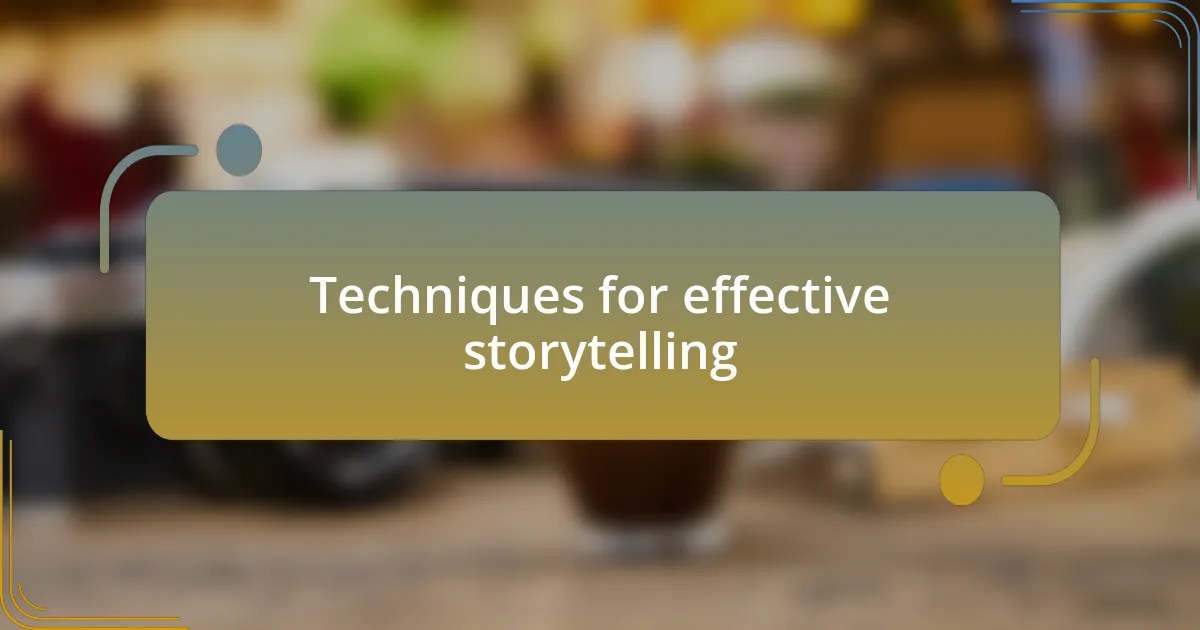
Techniques for effective storytelling
One effective storytelling technique I’ve embraced is the use of imagery to evoke emotions. In my recent film, I chose colors and lighting carefully to reflect the protagonist’s inner turmoil. This consideration transformed a simple scene into a haunting visual that continued to resonate with viewers long after the credits rolled. How can a well-chosen color palette change the way we feel about a story? It’s amazing to see how visual elements can amplify emotions, guiding the audience’s experience almost effortlessly.
Character development also plays a crucial role in storytelling. During a theater production I directed, I spent countless hours with my actors, diving deep into their characters’ backgrounds and motivations. This process not only built stronger performances but also created a sense of authenticity that audiences could feel. I often wonder, why is it so important for the audience to resonate with characters? Crafting relatable characters allows viewers to connect on a personal level, making the story more immersive.
Finally, pacing can make or break a story. In my experience, finding the right rhythm is essential for maintaining audience engagement. I recall a specific instance where I had to reshape a scene’s timing to sustain tension—a simple pause heightened the drama in ways I hadn’t anticipated. Isn’t it intriguing how sometimes silence can speak louder than words? Balancing action and reflection keeps the narrative dynamic and allows the audience to catch their breath without losing focus.
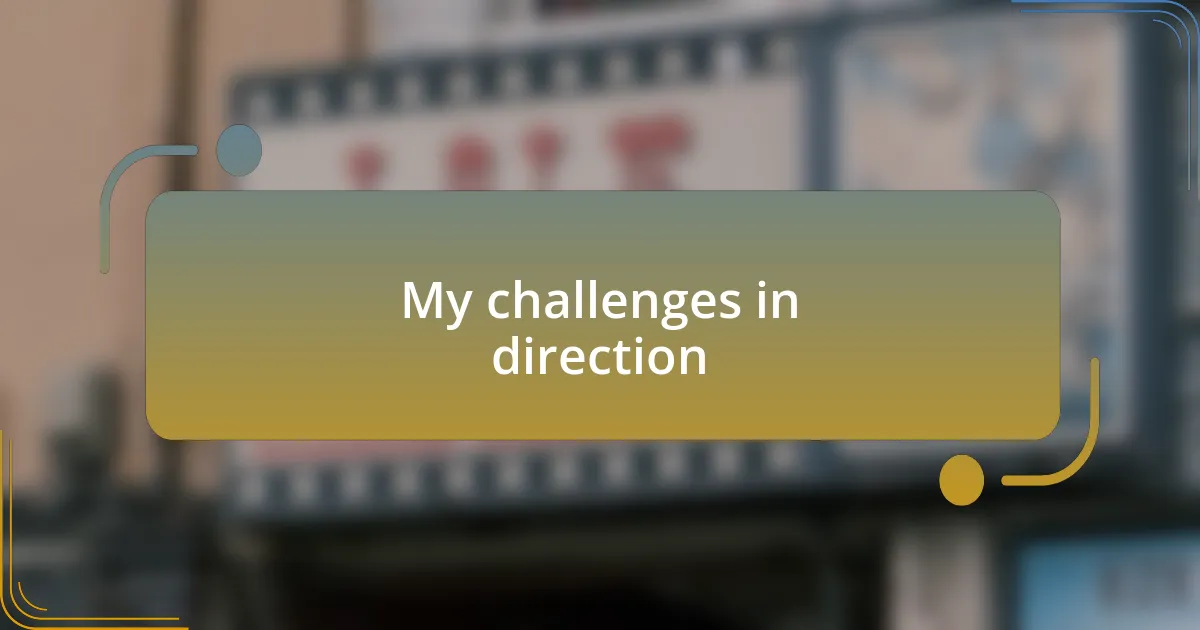
My challenges in direction
Navigating the diverse mediums of direction presents unique challenges. I vividly remember my first experience directing a short film after spending years in theater. The shift in pacing and performance styles left me grappling with the nuances of visual storytelling. How do you convey the same depth of emotion in a 10-minute film as you would in a two-hour stage production? It took quite a bit of trial and error before I found my footing, and even now, I still learn with every project.
Another significant hurdle was collaborating with various team members, each with their own creative vision. During a project for a web series, I faced clashes between the cinematographer’s vision and my own. It was a delicate dance of compromise — how do you ensure that everyone’s input enhances the story without diluting its essence? I learned that fostering open communication and creating a safe space for creative dialogue can truly bridge those gaps, allowing the best ideas to shine through.
Lastly, managing time constraints often weighs heavily on my directing experience. I once had to squeeze weeks of preparation into a mere ten days for a stage play. The pressure was palpable, and I found myself reminiscing about missed opportunities for deeper exploration. Reflecting on that experience, I now ask myself, what can I do to streamline my process without sacrificing quality? It’s become clear that prioritizing tasks and being clear about my vision helps create a more efficient workflow, leaving room for artistry to flourish even under tight deadlines.
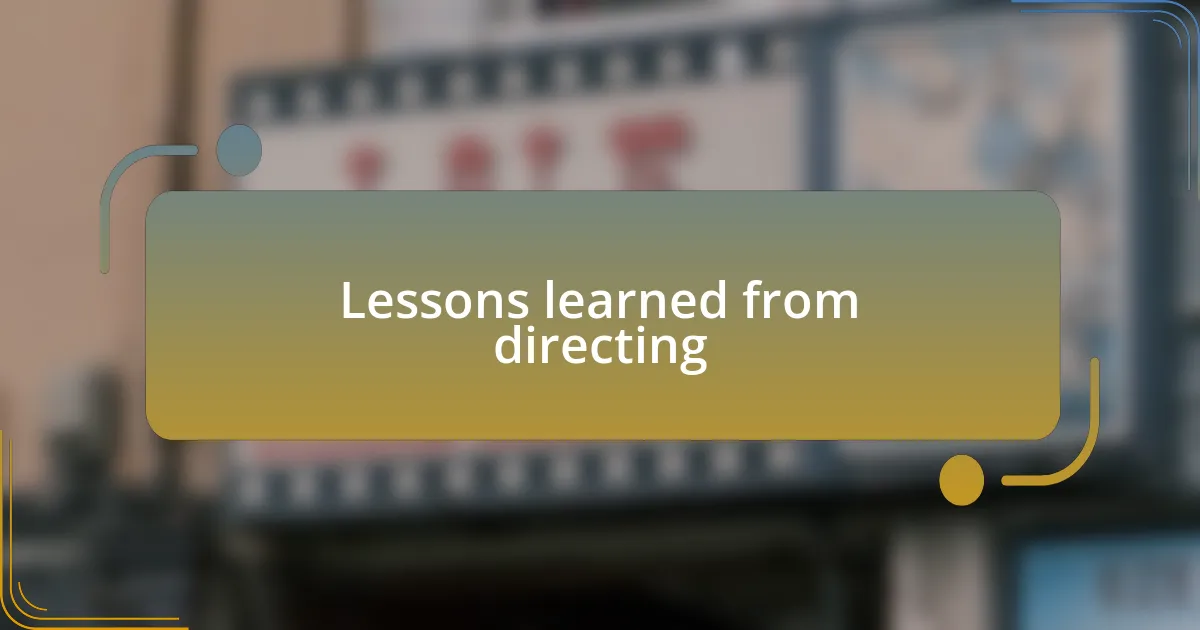
Lessons learned from directing
One of the most profound lessons I’ve gleaned from directing is the power of vulnerability. I remember directing a documentary where I encouraged my subjects to share their stories openly. At first, I was anxious, fearing that diving deep might unsettle the participants. But fostering this environment led to some of the most authentic and relatable moments on camera. It made me realize that vulnerability not only enriches the narrative but also connects everyone involved—both the storytellers and the audience. Have you ever noticed how a simple tear can speak volumes when captured just right?
Another key takeaway has been the art of flexibility. During a music video shoot, the entire schedule fell apart due to unforeseen weather conditions. I was frustrated, but rather than forcing the original vision, I chose to embrace the chaos. We improvised with the rain, capturing spontaneous moments that ultimately elevated the final product. This taught me that creativity often thrives in moments of unpredictability. How often do we hold on too tightly to our plans, neglecting the magic that could emerge from spontaneity?
Lastly, I’ve come to appreciate the importance of clarity in vision. Early in my directing career, I struggled to communicate my artistic ideas effectively to the team. There were times when I assumed everyone understood my creative intentions, only to find a disconnect during filming. Through that process, I learned that taking the time to articulate my vision, visually and verbally, cultivates a shared understanding that enriches collaboration. Have you ever sensed that a miscommunication could have been avoided with just a bit more clarity? This experience has made me a firm believer in the value of clarity; it transforms potential confusion into a unified creative force.

Applying experiences to future projects
Looking ahead to future projects, I draw heavily from the lessons I’ve learned. For instance, on one occasion, I found myself working with a diverse crew on a short film. Different backgrounds and experiences brought unique perspectives, which reminded me of the importance of open discussions. Now, I ensure to create spaces for collaborative idea-sharing, as embracing those diverse viewpoints often leads to richer storytelling. Have you ever underestimated the value of collective creativity?
I also recognize the significance of adaptability as I enter new projects. A highlight from my experience was during a theater production where last-minute changes to the script left the cast and crew scrambling. While it first felt like a setback, we quickly united and turned the situation into an opportunity for innovation. This taught me that a flexible approach not only enhances the creative process but also builds a resilient team spirit. How have unexpected challenges shaped your own creative journey?
Moreover, I’ve learned to maintain a strong sense of intention in my directing. After directing a web series that didn’t fully resonate with audiences, I reflected on my decision-making during the process. What seemed like artistic expression often led to disconnection. From this, I now prioritize aligning my vision with audience expectations, ensuring that every project I tackle communicates authentically and effectively. Have you ever felt the impact of understanding your audience on a deeper level? Balancing creative expression with audience connection can ultimately transform a good project into one that truly resonates.